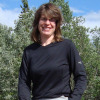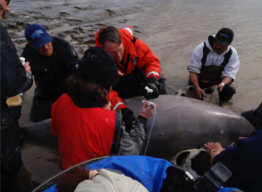‘Using numbers and variables to tell a story in the environmental sciences makes me happy’
Pam Maslyk wants you to see the natural world her way – through the lens of mathematics and their application.
After earning a graduate degree in pure mathematics (the study and development of math principles for their own sake), Pam pursued a passion for mathematics education. She is the recipient of two NASA grants, one to help fund doctoral research and the other to redesign an APU class that integrates different science and mathematics courses into one.
When she’s not teaching – which she considers “prime time” – Pam enjoys biking, hiking and skiing Anchorage’s many trails.
Pam, you’re known for making the most of technology, especially in online math classes, to help students succeed in your courses. Why are these interests important to you?
In science and mathematics, affordable handheld and computer-based technology allows our students to explore mathematics and real-world science as never before.
At APU, our online courses rely on technology that enhances communication and allows our virtual classrooms to thrive. Although they’re scattered all over the state, our students gather in one e-room. The online classroom atmosphere feels collegial, and our online students benefit from that.
What’s a math professor doing in the Environmental Science Department?
It’s true – I don’t work with the sciences exactly. But my courses support the sciences because math can be used to unlock all kinds of phenomena. It helps ES students assess data for themselves and form research-backed conclusions.
For instance, if we have the flow rate, math can determine the volume of water flowing in a river. Math can help reveal the chemical composition in samples of volcanic ash. If you understand mathematics, then you can discern for yourself information contained in a graph in a professional paper.
Mathematics has always been an exciting field for me. My students know that I think it’s amazing the way that numbers and variables may be used to tell a story in the sciences.
Even better is to see my students’ faces light up when they grasp the connection between math and the real world.
That connection – between the real world and math – happens pretty regularly for ES students as they’re working on senior projects, the capstone completed by all APU undergraduates.
Senior projects by Environmental Science students are getting more and more exciting every year. More students are applying mathematics to explain results that matter in the real world.
ES students completing their senior projects have worked with whale calls, sharks, fish behavior, octopuses and salmon counts. APU student research is adding to what we know about our environment.
An unforgettable research project was presented not long ago by an ES student who wanted to show that bears can see color. Our student worked with a captive bear at the Alaska Zoo here in Anchorage, designed and carried out her experiment, and showed us all that bears do indeed see primary colors. For us campers, that means thinking twice about buying a bright red tent!
What advice do you have for a student who’s new to the ES Department?
Look for ways to combine time in the field with time in class. If one of your professors is leading structured field research, find a way to join the project.
To help our ES students see the potential of science, they need to be out in the field, conducting real scientific inquiry. Our department does a pretty good job of this. And we’re getting better. But I’d like to see students gathering and analyzing data from Day One.
I’d tell our ES students not to delay their math courses. Developing good quantitative skills shows that you’re ready to enter your profession. Those skills will help make you in demand.


